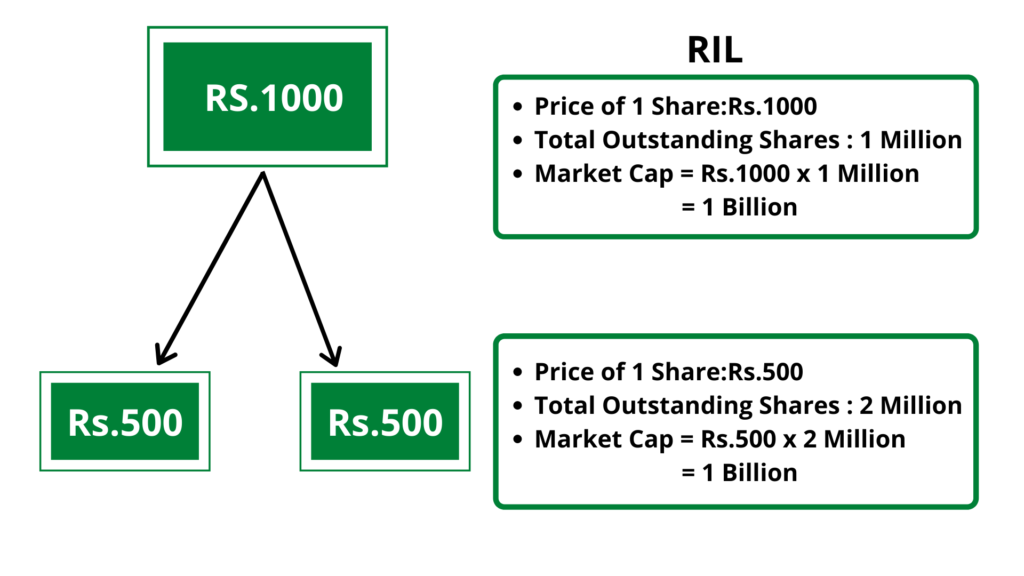What is a Stock Split and How Does it Work?

A stock split is an action in which a company divides its existing shares into multiple smaller shares. However, the market capitalisation of the company remains unchanged. A stock split does not dilute the ownership of shares. In this article, we will understand what a stock split is, the key factors driving it, its importance, and its advantages & disadvantages.
What is a Stock Split?
A stock split is a corporate action in which a company divides its existing shares into multiple shares of a smaller price. The primary goal of a stock split is to increase the number of outstanding shares while decreasing the price per share. This process does not affect the company’s market capitalisation or total value.
A company generally announces a stock split to make it cheaper to buy, making it more affordable for a small retail investor. It increases the demand for the stock and provides the company with liquidity (or cash in hand).
For example, the current market price of MRF Ltd is ~₹1,09,000 per share (as of September 28, 2023). Most retail investors would not be able to buy even 1 share of the tyre manufacturer. However, they are more likely to buy it if the shares are priced at ₹1,000. The company can do a stock split in this situation to make it affordable for retailers.
Impact of Stock Split on a Company:
- Market capitalization remains the same.
- Demand for stock increases.
- Share price: First decreases and then gradually starts to increase.
- No. of outstanding shares increases.
- Earning Per Share and dividend decrease.
How Does a Stock Split Work?
A stock split is a process that involves dividing a company's existing shares into a larger number of new shares with a lower price. Here's how it typically works:
1. Company Decision
A company's Board of Directors decides whether to initiate a stock split. The decision is usually taken in response to various factors, such as the desire to make the stock more affordable for investors or increase liquidity. However, it also reduces the company’s Earnings Per Share (EPS), making it less attractive.
2. Announcement
After the decision is made, the company publicly announces the stock split. In the announcement, the company will specify the split ratio (e.g., 2:1, 3:1, etc.) and the split’s effective date.
What is a Split Ratio?
A split ratio is a numerical expression that indicates how a company's shares will be divided or split during a stock split.
Consider a split ratio of 2:1. The company increases the number of its outstanding shares by dividing each existing share into two new shares. This means that for every single share an investor owns before the split, they will receive two shares after the split.
For example, if you own 100 shares of a company's stock trading at ₹100 per share, and the company undergoes a 2:1 stock split, you will now own 200 shares, but each of these new shares will be valued at ₹50. The overall value of your investment remains unchanged at ₹10,000 (100 shares x ₹100 before the split = 200 shares x ₹50 after the split).
3. Record Date
The company determines a record date, also known as the "split date." Shareholders who own the stock on this date will be eligible to receive the additional shares resulting from the split.
4. Split Execution
On the effective date, the stock split is executed. For example, in a 2:1 stock split, for every share a shareholder owns, they will receive two new shares. The total number of outstanding shares increases, but the individual share price decreases proportionally.
5. Demat Credit
The additional shares resulting from the split are credited to the shareholders' demat account. Shareholders do not need to take any action to receive these additional shares.
6. Adjusted Share Price & Trading
After the split, the share price is adjusted to reflect the new ratio. For example, if a company's stock was trading at ₹1,000 per share before a 2:1 split, it would trade at ₹500 per share after the split. The trading symbol for the stock remains the same, only the price and the number of shares available have changed.
How Does a Stock Split Affect Share Price, Volume, and Liquidity?
Share Price
When a company does a stock split, they make more shares, and each one becomes cheaper. For example, suppose you had one stock worth ₹1,000 before. After a 2:1 split, you'd have two shares, and each would be worth about ₹500.
This lower price often makes it more affordable to investors. So, more retail investors might want to buy the stock, even if they couldn't before because it was too expensive. But in the short run, the price can get volatile.
Volume
After a stock split, the volume of trading in the stock increases as the shares are now cheaper.
Liquidity
Liquidity refers to the ability to buy and sell stock at the desired price without significantly affecting the stock's price. Stock splits improve liquidity by increasing the number of shares available for trading. Lower share prices resulting from a split can make the stock more accessible to a wider range of investors, including retail investors. This increased accessibility can further boost liquidity as more investors participate in trading.
Practical Examples of Stock Split
Example 1: A company ABC, whose value of each share is $30, announces a stock split such that the value of each share is 1/3rd the value of its original price. The company does so by dividing the value of one stock by three. Therefore, the value of each share will become $10, and the sum of three such stocks will be $30. So the value held by investors remains constant.

Example 2:
- Let us assume that you hold 100 shares of Reliance Industries (RIL). Each share of RIL costs Rs. 1,000. Therefore, you hold shares worth ₹100,000 in total.
- Let us also assume for convenience that the total number of outstanding shares is 1,000,000 (1 million). So market capitalization will be 1,000,000,000 (1 Billion).
- One fine day, RIL announces a stock split in the ratio 1:1 (one extra share for every one share held in the company). This means that the total number of outstanding shares will be 2,000,000 (2 Million) but the market capitalization still remains 1 Billion at the moment.
- When RIL announces the stock split, the number of shares you held would double. But their total value still remained the same i.e. ₹100,000. And the value of each share that you hold will be half i.e. Rs.500 (₹1,000 divided by 2).
- After this, you can expect a decline in price due to the excess supply of shares in the market. Later, the price will surge due to increased demand, thereby raising liquidity for the company.

Advantages and Disadvantages of Stock Splits
| Advantages | Disadvantages |
| Stock splits result in more shares being available in the market, which can increase trading activity and liquidity. It will make it easier for investors to buy and sell shares. | A stock split doesn't change the fundamental value of a company. If the stock was overvalued before the split, it will still be overvalued after the split. |
| After a stock split, the share price typically decreases. This can make the stock more affordable to a wider range of investors, potentially attracting new buyers. | Buying or selling more shares due to the split may result in increased transaction costs, especially if investors/traders have to pay commissions or fees for each trade. |
| A stock split can create a positive perception among investors. It may be seen as a sign of confidence by the company's management, which can boost investor sentiment. | The company needs to pay different costs like legal & exchange fees while splitting its stock. |
In conclusion, a stock split is only a corporate event that adjusts the number of shares and their prices. However, it doesn't alter the company’s fundamentals, unlike other corporate actions such as a bonus issue. Stock splits are often welcomed by investors because they make shares more affordable and boost trading activity. Remember, always study and understand a company’s fundamentals before investing!


Post your comment
No comments to display